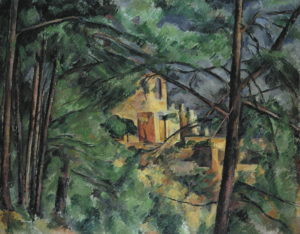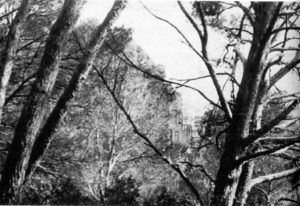R522 – Château Noir derrière les arbres (FWN237)
Pavel Machotka
(Cliquer sur les images pour les agrandir)
In Château Noir derrière les arbres Cézanne uses a fine touch to create a rhythmical, almost willful composition: he paints an obliquely inclined framework of branches and pine needles to enclose the vertical building[1]. The geometry is not willful in the literal sense, of course, since the trees really did lean to the right and some branches did point upward, as later photographs of the site show. The composition was a matter of choice and the touch was a matter of emphasis: the choice was of that particular view through the trees and the emphasis was on the touch echoing the diagonal branch. With the branch as a given, the painting is integrated by the logic of Cézanne’s touch. In La Meule et citerne en sous-bois (R764 FWN292) and Sous-bois (R543 FWN209) the touch had many more structural lines to respond to and could take many directions; here, it has above all the emphatic diagonal to support and subdue. Minor touches are also placed against the small branches that enclose the building on the left side—the local balance being more important, and more interesting, than imposing the scheme arbitrarily. The touches balance the geometry and soften it; their effect, in spite of the logic of their construction, seems natural. The colors of the sky and the pine needles are very much as we see them now, but the building in the painting is darker and the door redder; whether they have bleached with time, or whether Cézanne made then more saturated to balance the color, is unclear. In any case, all three hues are here of about the same value, and the building and door are warm and saturated; the painting is splendidly unified and balanced, and happily resolved in the swirl of its tensions.
Le site vers 1935 et aujourd’hui :
Source: Machotka, Cézanne: Landscape into Art.
[1] Rewald dates the painting « c. 1885 (possibly later) », but from its resemblance to La meule et citerne en sous-bois and Sous-bois it must be from about the mid-nineties.




